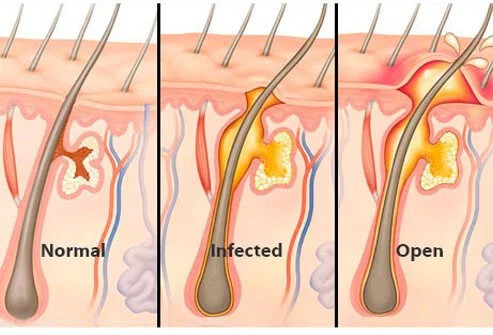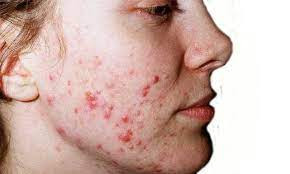Definition
Furunculosis is a skin abscess involving the hair follicles and the surrounding area. A skin abscess is a collection of pus beneath the skin's surface. Furunculosis can occur in any hair follicle on the body, not just those on the scalp. The most common sites for furunculosis include the neck, chest, face, and buttocks.
Causes
Furunculosis is mainly caused by the bacteria Staphylococcus aureus. This bacteria usually lives on human skin without causing harm, especially in areas such as the nostrils, armpits, thighs, and buttocks. However, it can spread to other parts of the body through scratching or skin injuries.
Some individuals with Staphylococcus on their skin may develop furunculosis. Small wounds, such as those caused by scratching, allow the bacteria to enter hair follicles, which are vulnerable points in the skin's defence system. Once inside, the immune system fights the bacteria, leading to the formation of furuncles as white blood cells work to eliminate the infection.
Furunculosis can also be caused by Staphylococcus MRSA (Methicillin-resistant S. aureus), a strain resistant to the antibiotic methicillin. If MRSA is the cause, furuncles are more challenging to treat and require specific antibiotics.
Risk factor
While furunculosis can affect young and healthy individuals, it is more common in:
- People with obesity.
- Individuals with weakened immune systems.
- The elderly.
- People with diabetes.
- Individuals with dermatitis, who are prone to scratching and creating entry points for Staphylococcus aureus.
- Those with anemia or low iron levels.
- Smokers.
- Individuals with other medical conditions that impair wound healing.
Additional risk factors include living in densely populated areas with poor hygiene, close contact with infected individuals, hot and humid climates, and blockages in hair follicles (such as blackheads).
Symptoms
Infected hair follicles become inflamed, initially appearing as small reddish bumps that resemble pimples. As the infection progresses, these bumps become more painful and hard. The surrounding skin may become red, swollen, and tender.
A fully developed furuncle appears as a red, raised bump at a hair follicle, filled with pus from the body's fight against infection. Pressure from the fluid buildup can cause the furuncle to rupture, releasing pus. The pain usually peaks just before the furuncle bursts and subsides afterwards. Pain may be more intense in sensitive areas such as the nose, ears, or fingers. Scarring may occur from furuncles.
Diagnosis
A doctor can typically diagnose a furuncle based on its appearance. If a furuncle does not heal with initial treatment, a bacterial culture may be performed on a sample of the furuncle's fluid to identify the specific bacteria and guide more targeted antibiotic therapy.
Management
The treatment of furunculosis depends on the severity of the condition. The following measures can be taken to manage furunculosis:
- Warm compresses: Applying warm, moist compresses to the furuncle throughout the day can help speed up its bursting and draining. Once the furuncle bursts, warm compresses can be continued to reduce pain and promote healing.
- Wash your hands and the affected area with antibacterial soap to prevent the spread of Staphylococcus bacteria to other parts of the body.
- Apply antiseptic ointment or gel to the furuncle.
- Wipe the entire surface of the skin with 70% isopropyl alcohol to clean the area, although this may cause dry skin.
- Antiseptics such as povidone-iodine cream or chlorhexidine can be applied to the furuncle, which should then be covered with gauze.
- For persistent or very painful furuncles, a doctor may prescribe oral antibiotics, such as flucloxacillin, trimethoprim/sulfamethoxazole, clindamycin, doxycycline, or minocycline. These antibiotics, targeting Staphylococcus bacteria, may be prescribed for several weeks. Oral antibiotics are usually recommended for:
- Furuncles larger than 5mm or smaller furuncles that do not heal after draining.
- Multiple furuncles.
- Deep and widespread infections.
- Individuals with weakened immune systems.
- Those at risk of heart infections (e.g., endocarditis due to Staphylococcus).
- Patients with a fever.
- In cases where furuncles do not resolve on its own or are very painful, a doctor may perform a minor surgical procedure to drain the pus using sterile instruments. Patients should avoid attempting to drain the furuncle themselves, as squeezing, pulling, or cutting can increase the risk of deeper infection and severe scarring.
Furuncles often recur and can be prevented by using liquid soap containing chlorhexidine gluconate with isopropyl alcohol or chloroxylenol 2-3%. Long-term antibiotic therapy for 1-2 months may be recommended. Underlying conditions such as obesity or diabetes should also be addressed to prevent recurrence.
Complications
Most furuncles heal without medical intervention and do not lead to complications. However, in rare cases, furuncles can cause:
- The spread of infection to deeper tissues, leading to more severe symptoms such as fever and chills.
- The spread of infection into the bloodstream, which can occur if furunculosis is not treated properly. This can result in the infection spreading throughout the body and potentially damaging multiple internal organs.
Prevention
Furunculosis can be prevented by adopting a clean and healthy lifestyle:
- Consult with a doctor about your overall health.
- Lose weight if you are overweight, and engage in regular exercise.
- Eat a balanced diet that includes meat, fruits, and vegetables.
- Quit smoking
- Shower daily with soap and running water.
- Wash your hands frequently.
- Avoid sharing clothes, towels, and other personal items with others.
- Change clothes and underwear regularly.
- Avoid picking your nose with your hands.
- Reduce activities that cause excessive sweating and skin friction against clothing.
- If you have an iron deficiency, take iron tablets as recommended by your doctor.
- Avoid close contacts with infected people
If infected with Staphylococcus sp., do these steps:
- Wash your hands frequently.
- Follow your doctor's wound care instructions.
- Avoid sharing personal items.
- Wash linens in hot water to kill bacteria.
When to see a doctor?
Most individuals do not need to see a doctor for furuncle treatment. However, if the furuncle remains large, does not burst, or is very painful for more than two weeks, medical attention is advised. Typically, furuncles will burst, drain, and begin to heal within that time frame.
Looking for more information about other diseases, Click here!
- dr Anita Larasati Priyono
What to Know About Furuncles (Boils). Healthline. (2022). Retrieved 22 March 2022, from https://www.healthline.com/health/furuncle.
Furuncles and Carbuncles - Dermatologic Disorders - MSD Manual Professional Edition. MSD Manual Professional Edition. (2022). Retrieved 22 March 2022, from https://www.msdmanuals.com/professional/dermatologic-disorders/bacterial-skin-infections/furuncles-and-carbuncles.
Boils (furunculosis) | DermNet NZ. Dermnetnz.org. (2022). Retrieved 23 March 2022, from https://dermnetnz.org/topics/boil.











